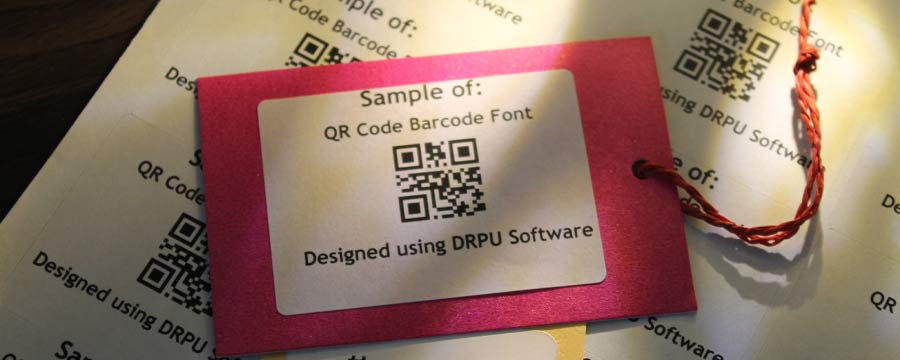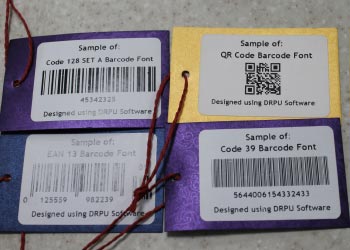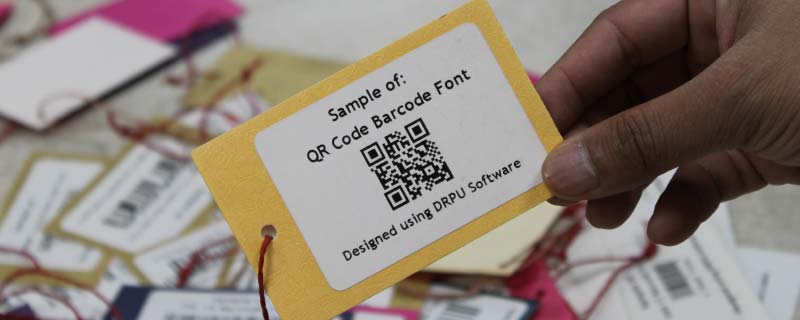Key Points of QR Code Barcode:-
-
The primary purpose of QR codes is to store and quickly retrieve information. They are used to encode various types of data such as website URLs, product information, contact details, promotional offers, and many more. The versatility and ease of use of QR codes have made them popular in various industries, including marketing, advertising, helthcare, and retail.
-
QR codes are known for their ability to store a large amount of information in a small space. They are capable of encoding up to several hundred alphanumeric characters, which is significantly more than the traditional 1D barcode. QR codes can also be customized to include company logos, colors, and other design elements, making them an attractive marketing tool.
-
QR codes can be printed on a variety of surfaces, including paper, plastic, and metal. They can be printed in various sizes, with the smallest QR codes measuring just a few millimeters. This flexibility in size makes QR codes adaptable to different types of applications and products.
-
QR codes can also be used for tracking and analytics purposes. By embedding a unique code in each QR code, companies can track the number of scans and gain insights into customer behavior. This information can be used to improve marketing strategies and make data-driven decisions.
-
One of the unique features of QR codes is their error correction capability. QR codes can withstand damage and still be readable because of the redundant information encoded in them. Even if up to 30% of the QR code is damaged or obstructed, the remaining 70% can still be read, which is particularly useful in real-world scenarios where codes may become partially damaged or dirty.
The Purpose of Using a QR Code Barcode
A QR Code (Quick Response Code) is a two-dimensional barcode that can be scanned using a mobile device or specialized scanner. It was invented in 1994 by the Japanese company Denso Wave and is widely used in various industries and applications. In this article, we will discuss the purpose of using QR Code Barcodes and their benefits.
-
The main purpose of using QR Code Barcodes is to quickly and easily provide information to users. QR Codes can be used to store a variety of data, including text, URLs, email addresses, contact information, product information, and more. By scanning a QR Code, users can instantly access the information stored within it without having to type or search for it manually.
-
One of the main advantages of using QR Code Barcodes is their ease of use. QR Codes can be scanned using a smartphone or tablet camera, which most people already have with them at all times. There is no need for special equipment or software, and the scanning process is quick and straightforward. QR Codes can also be printed on a variety of surfaces, including paper, plastic, and even fabric, making them accessible in many different environments.
-
Another advantage of QR Code Barcodes is their versatility. QR Codes can be used in a wide range of industries and applications, including advertising, marketing, inventory management, product tracking, event management, and more. They can be used to provide customers with more information about a product or service, to track inventory and shipments, to manage events and registrations, and to facilitate payments and transactions.
-
QR Codes are also highly customizable- Users can create QR Codes with different designs, colors, and sizes to match their branding and marketing materials. This can help to increase brand recognition and visibility and make QR Codes more appealing to users.
-
QR Codes offer a high level of security- QR Codes can be encrypted to ensure that the data they contain is only accessible to authorized users. This is particularly important for sensitive information, such as financial data or personal information.
In summary, the purpose of using QR Code Barcodes is to provide quick and easy access to information for users. QR Codes are versatile, customizable, and offer a high level of security, making them an ideal solution for a wide range of industries and applications.
Download and Install Barcode Software
Encoded Information in a QR Code
A QR (Quick Response) Code is a two-dimensional barcode that can encode various types of data such as text, URL, contact information, and even multimedia files. It was first introduced by Denso Wave, a subsidiary of Toyota, in 1994 for the purpose of tracking automotive components during the manufacturing process. Since then, QR codes have become widely popular due to their ability to encode large amounts of data in a small space and can be easily scanned by mobile devices.
QR codes can also be used to encode various types of data, including:
-
Email addresses:
QR codes can encode email addresses, allowing users to quickly send an email to the recipient's encoded address present in the QR code.
-
Text:
QR codes can encode plain text, such as messages, notes, and instructions. When scanned, the text is displayed on the user's device.
-
URLs:
QR codes can encode website URLs, allowing users to easily access a specific website without having to type in the URL manually.
-
Geolocation data:
QR codes can encode geolocation data, such as GPS coordinates. When scanned, the user's device can display the location on a map.
-
Wi-Fi network information:
QR codes can encode Wi-Fi network information, like name and password. When scanned, the user's device can automatically connect to the Wi-Fi network.
-
Payment information:
QR codes can encode payment information, such as a bitcoin wallet address or a credit card number. When scanned, the user's device can initiate a payment transaction.
-
Multimedia files:
QR codes can encode multimedia files, such as images, videos, and audio files. When scanned, the user's device can download and play the multimedia file.
-
Contact information:
QR codes can encode contact information, such as a name, phone number, and email. When scanned, the user can save the contact information to their device's address book.
Overall, the flexibility of the data types that can be encoded in a QR code makes it a useful tool for a variety of applications, including advertising, marketing, inventory management, and product tracking.
Industries that are Commonly use QR Code Barcode
QR code (Quick Response Code) is a type of two-dimensional barcode that has gained popularity due to its high capacity for data storage and fast readability. As a result, QR codes have been adopted by many industries and are used for various purposes. In this response, we will discuss the common industries that use QR codes and their applications.

-
Retail and Marketing Industry:
QR codes have become increasingly popular in the retail and marketing industry, as they provide a quick and easy way to access information about products and promotions. For instance, retailers can use QR codes to provide product information, such as ingredients, nutritional information, and manufacturing details. QR codes can also be used in marketing to provide discounts, special offers, and loyalty programs to customers. Furthermore, QR codes can be printed on receipts, packaging, and posters to encourage customers to engage with brands on social media, leave reviews, or sign up for newsletters.
-
Healthcare Industry:
In the healthcare industry, QR codes are used to store and access medical records and patient information. For example, QR codes can be placed on patient wristbands, medication labels, and laboratory samples to provide quick and accurate access to patient data. Additionally, QR codes can be used to verify the authenticity of medical devices, such as implants, and to track medical equipment and supplies.
-
Transportation and Logistics Industry:
QR codes are used in the transportation and logistics industry to track and manage shipments, inventory, and assets. For example, QR codes can be printed on shipping labels, packaging, and invoices to provide information about the origin, destination, and contents of a shipment. QR codes can also be used to track assets, such as vehicles, equipment, and tools, to ensure their proper maintenance and prevent theft.
-
Education Industry:
QR codes have been increasingly used in the education industry to provide students with access to digital resources, such as textbooks, lectures, and quizzes. For instance, QR codes can be placed in textbooks and on classroom materials to provide students with supplementary resources and interactive content. Additionally, QR codes can be used in field trips and outdoor learning to provide information about historical sites and natural landmarks.
-
Entertainment Industry:
The entertainment industry has also adopted QR codes for various purposes. For instance, QR codes can be used to provide information about upcoming events, concerts, and movies. They can also be used to distribute digital content, such as music, videos, and games. Additionally, QR codes can be used in theme parks and museums to provide visitors with access to interactive exhibits, audio guides, and maps.
-
Government and Public Services:
QR codes are used in the government and public services to provide citizens with access to public information and services. For instance, QR codes can be used to provide access to public transportation schedules, traffic reports, and emergency alerts. Additionally, QR codes can be used to provide citizens with access to public records, such as land records, building permits, and court documents.
-
Financial Industry:
QR codes are also used in the financial industry for various purposes. For instance, QR codes can be used to facilitate mobile payments and transfers, enabling customers to pay for products and services using their smartphones. Additionally, QR codes can be used to access and manage online banking services, such as account balances, transaction histories, and bill payments.
In Summary, QR codes have become increasingly popular due to their high capacity for data storage and fast readability. They are used by various industries for a wide range of applications, including retail and marketing, healthcare, transportation and logistics, entertainment, education, finance, and government and public services.
Difference of QR Code Barcode from Other Types of Barcodes
A QR Code, or Quick Response Code, is a type of two-dimensional barcode that can store more data than traditional linear barcodes. Unlike linear barcodes, which encode data horizontally, QR codes can encode data both horizontally and vertically, allowing them to store much more information in a smaller space. QR codes are also designed to be read quickly and easily by mobile devices, making them a popular choice for applications such as mobile marketing, ticketing, and payment systems.

One of the key differences between QR codes and other types of barcodes is the way that they encode data. Traditional linear barcodes encode data in a series of bars and spaces of varying widths, while QR codes use a matrix of black and white squares to represent data. This matrix allows QR codes to store much more information than linear barcodes, making them more versatile and useful in a wider range of applications.
Another important difference between QR codes and other types of barcodes is the way that they are read. While traditional barcodes require a laser scanner to read the information encoded in them, QR codes can be read using a smartphone or other mobile device with a built-in camera. This allows QR codes to be used in a wide range of applications, from mobile payments and ticketing to inventory management and supply chain tracking.
QR codes also have a number of advantages over other types of barcodes. For one, they can be read quickly and easily by mobile devices, making them ideal for applications such as mobile marketing campaigns and mobile payments. QR codes can also be customized with logos or other graphics, making them more visually appealing and memorable than traditional barcodes. Additionally, QR codes can be used to store a wide range of data types, including URLs, text messages, phone numbers, and even small images or videos.
Overall :- the main difference between QR codes and other types of barcodes is their ability to store large amounts of data in a compact and easily readable format. This makes them a versatile and useful tool for a wide range of applications, from mobile marketing and advertising to inventory management and supply chain tracking.
Posted By: 👤 Techsavvy
|Updated On: 📅
